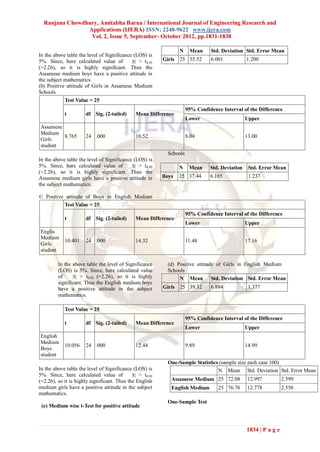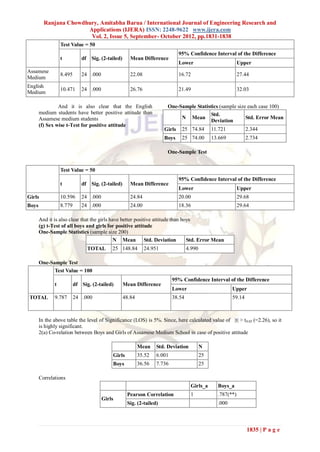The paper investigates the factors influencing students' attitudes towards mathematics and their subsequent academic achievements. It explores various variables such as home environment, parental attitudes, medium of instruction, and classroom dynamics using a sample of secondary school students in Assam. The study employs statistical methods to analyze these relationships and highlights the significant impact of attitudes on learning outcomes in mathematics.
![Ranjana Chowdhury, Amitabha Barua / International Journal of Engineering Research and
Applications (IJERA) ISSN: 2248-9622 www.ijera.com
Vol. 2, Issue 5, September- October 2012, pp.1831-1838
Identification Of Some Of The Factors In The Formation Of
Attitude Towards Mathematics
Ranjana Chowdhury, Amitabha Barua
Department of Computer Application Assam Engineering College Guwahati 781013, Assam
Abstract
This paper reveals the results of the Council of Teachers of Mathematics (1989) and
investigation carried out to study some sort of National Research Council have urged educationists
possible relationship that might occur in case of of the country to incorporate effective factors in the
formation of attitude towards mathematics and cognitive domain of school children, [ 1,4,5,6,10] .
to find the factors that are responsible for the It appears sometimes that brilliant students
purpose . The investigation mainly deals with possess a good attitude towards learning
“attitude - factors” related to parents together mathematics. But the same has not yet been fully
with the medium of instruction and also and scientifically established. It is also observed that
considering “sex- factors” as another one . For researchers in India and abroad give much emphasis
this purpose, a sample of two hundred secondary on the relationship between attitude towards
school students have been chosen so as to study mathematics (ATM) and achievements in
such relation where the variables are chosen mathematics (AIM).
above – type of “ attitude factors” together with
the others mentioned above .The correlation 2. Significance of Study
technique and “ t- statistics” are playing key role Some of the studies in this area are mentioned
in our investigation . and thereby we estimate below:
direct and indirect influence of independent Pinkrah’s, in the year 1989 studied about
variables on the dependent one .Interestingly, we pupils „„Attitude towards understanding
find the direct effect on the formation of attitude mathematics‟‟ and revealed that, enjoyment with
towards mathematics. mathematics and liking of mathematics were
Key words: Attitude –factors Statistical Correlation stronger determinants for learning the subject with
/ t- test less difficulty.
1. Introduction Armstrong, in the year 1993 conducted a
We all know that from the time of antiquity descriptive study of the „„interrelationship of parent,
mathematics has been playing a vital role in teacher and student attitude towards mathematics
upgrading human culture and civilization in addition and school achievement of selected eight grade
to developing science and technology. Its use in students in the Inglewood Unified School District.‟‟
expanding human knowledge and thought is A significant relationship was found between
immense. For over all uplift of the human society, attitude towards mathematics of students and
the mankind needs skilled and trained persons in parents, but not of students and their mathematics
mathematics. Mathematics has through the ages, teachers.
produced men of quality. E.T.Bell, in his books
Men of Mathematics, observes- “As a group the Pal, A. in the year 1989 considered „„the
great mathematicians have been men of all round dependence of achievement in mathematics on four
ability, vigorous, alert, keenly interested in many variables of the effective dimension viz. (i) self
things outside mathematics. . concept, (ii) anxiety, (iii) attitude and (iv) academic
However, now a day instead of getting motivation‟‟.
increasingly interested in learning mathematics, our He formulated 56 hypotheses with these
school students have been found lacking in aptitude variables and classified the students into urban,
to be As such it has become the necessity of the semi-urban and rural and male and female groups.
hour to identify the causes responsible for large He found the regression equation to predict the
scale failures in the subject. Otherwise within a performance in mathematics as a linear combination
short span of time, skilful and trained persons in of the four affective variables.
mathematics will vanish from our country. It will
then be a disaster for us. Chel in the year 1990 in his study
A number of researchers in India and examined „„the problem of underachievement in
abroad have investigated into the relationship compulsory mathematics in Madhyamic
between the effective and the cognitive domains of Examination of West Bengal‟‟. He found the
teaching and learning mathematics. National following causes responsible for underachievement:
1831 | P a g e](https://image.slidesharecdn.com/kl2518311838-121002065055-phpapp02/85/Kl2518311838-1-320.jpg)
![Ranjana Chowdhury, Amitabha Barua / International Journal of Engineering Research and
Applications (IJERA) ISSN: 2248-9622 www.ijera.com
Vol. 2, Issue 5, September- October 2012, pp.1831-1838
(i) Gaps in knowledge of mathematics concepts. examining the responses of 545 students. The data
(ii) Difficulties in understanding mathematical represent all grade levels and subject of the
language. secondary mathematics curriculum. This reliability
(iii) Lack of openness and flexibility in teaching. coefficient alpha was ·97. A maximum likelihood
(iv) Difficulties in mathematization of verbal factor analysis with a varimax rotation yielded four
problems and interpretation of mathematical results. factors; self-confidence; value of mathematics;
(v) Abstract nature of mathematics. enjoyment of mathematics; and motivation.
(vi) Fear and anxiety on the part of the students. Psychometric properties were sound and the
The study suggests greater motivation of instrument. Attitude toward Mathematics Inventory
the students for learning mathematics, removal of (ATMI), can be recommended for use in the
fear of mathematics and clearer presentation of investigation of students‟ ATM
subject based on the need of the children. Pierce, R., Stacy, K., Borkortsas, A., in the year
Rosaly, A., in the year 1992 had studied on „„the 2005 studied about “A scale for monitoring
relationship between attitude of students towards student‟s attitudes to learning mathematics with
mathematics and achievement.‟‟ The investigator technology.” This paper presents a model of how
showed the following major findings: technology use can enhance mathematics
(i)The attitude of high school students towards achievement, a review of other instruments and a
learning mathematics and their achievement in psychometric analysis of the MTAS. It also reports
mathematics were related. the responses of 350 students from six schools to
(ii)Urban girls had a more positive attitude towards demonstrate the power of the MTAS to provide
mathematics. Similarly, urban boys had a more useful insights for teacher and researchers. „Attitude
positive attitude towards mathematics than rural to learning mathematics with technology‟ had a
boys. wider range of scores from other variables studied.
(iii)Girls were higher than boys in their For boys, this attitude is correlated only with
achievement in mathematics. confidence in using technology, but for girls the
(iv)Urban girls were higher than rural boys in only relationship found was a negative correlation
mathematics . with mathematics confidence. These difference need
Hariharan, D., in the year 1992 studied on „„the to be taken into account when planning instruction, [
attitude of high school students towards home work 2, 3, 4, 7, 8, 9 ] ..
and their achievement in mathematics.‟‟ It is observed that though achievement in
The following were showed in his thesis: mathematics seems to be positively related to
(i)Girls were higher than boys in their attitude attitude towards mathematics, but little effort has
towards home work. been made to investigate how that attitude is
(ii)Urban students were students were higher than formed.
rural students in their attitude towards home
work. 3. Problems of the Investigation:
(iii)Private school attitude students were higher In this study we want to identify some of
than the government school students in their the factors responsible for formation of attitude of
attitude towards home work. the pupils in secondary stage towards mathematics
It is observed that though achievement in in relation to 1. home environment, 2. father‟s
mathematics seems to be positively related to attitude towards mathematics, 3. mother‟s attitude
attitude towards mathematics. But little effort has towards mathematics, 4. pupils achievement in
been made to investigate how that attitude is mathematics in school internal examinations, 5.
formed. medium of instruction, 6. class environment, 7.
Mohammad Miyan in a trend report Survey of some social factors, 8. sex.
Research in Mathematics Education edited by Buch Objective of the Study:
remarks “Though attitude towards mathematics 1. To enquire into the relationship between attitude
seems to be positively related to achievement, no towards mathematics and achievement in
effort has been made to investigate how that attitude mathematics.
is formed” . We through this study 2. To investigate into the relationship between home
want to identify some of the factors responsible for environment and attitude towards mathematics.
formation of attitude towards mathematics and 3. To identify relationship between father‟s attitude
select the following topic for the present study. towards mathematics and pupil‟s attitude towards
Tapia, M., Marsh II, George E., in the year 2004 mathematics.
in the Academic Exchange Quarterly, Vol. 8, and 4. To identify relationship between mother‟s attitude
Issue 2 studied about “An instrument to measure towards mathematics and pupil‟s attitude towards
mathematics attitudes.” This research paper to mathematics.
reports of the development of a new instrument to 5. To investigate the relationship between attitude
measure students‟ ATM, and to determine the towards mathematics and pupils of Assamese and
underlying dimensions of the instrument by English medium schools.
1832 | P a g e](https://image.slidesharecdn.com/kl2518311838-121002065055-phpapp02/85/Kl2518311838-2-320.jpg)





